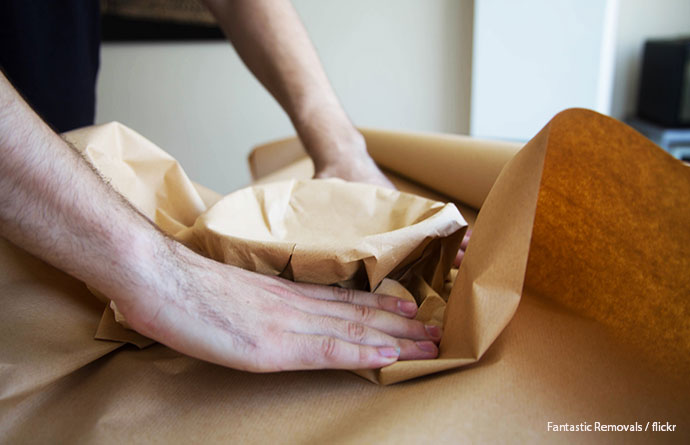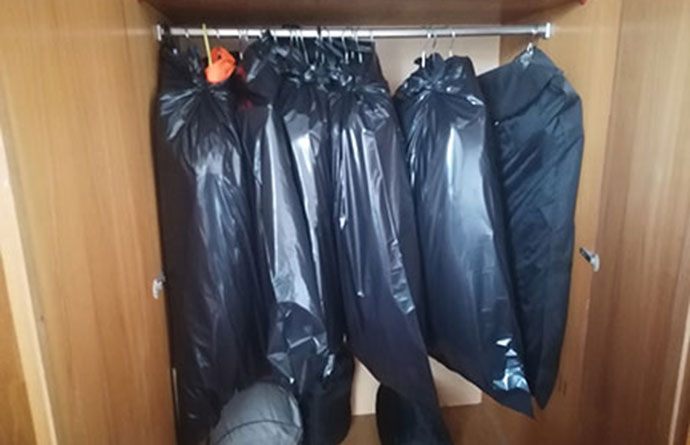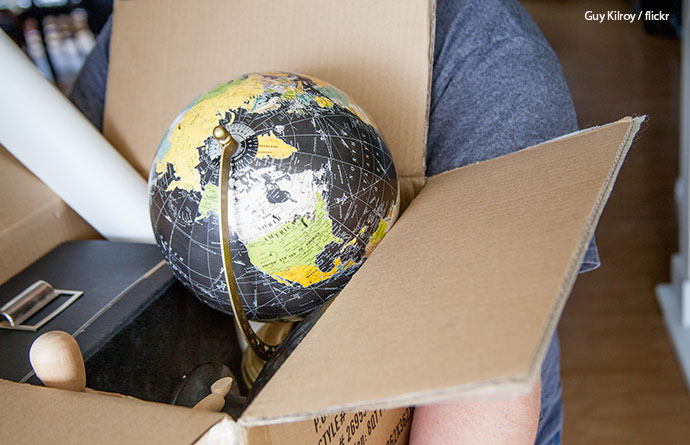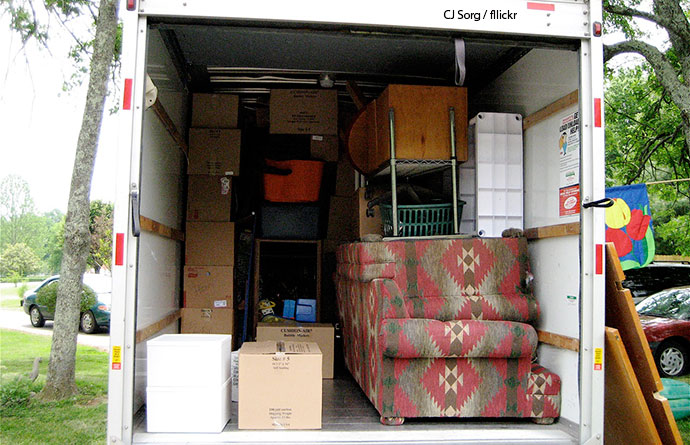
- 12 Packing Tips for Moving to Save Space, Time, and Money
- Tip #1 Declutter Before Moving
- Tip #2 Keeping Clothes in Drawers
- Tip #3 Pack Like Russian Dolls
- Tip #4 Pack with Things You Have Around the Home
- Tip #5 Fill Rubbish Sacks
- Tip #6 Is it Better to Roll or Fold Clothes for Packing?
- Tip #7 Use Vacuum Sealed Bags
- Tip #8 Fill Each Box
- Tip #9 Use Original Boxes
- Tip #10 Use Small and Medium Boxes
- Tip #11 Dismantle Furniture
- Tip #12 Load the Removal Van Like a Jigsaw
Packing for a home move is arguably the worst part of the whole home-moving process.
It is time-consuming, laborious, and expensive.
For the few extra pounds it costs, then hiring a professional packing service to pack your belongings for you is usually very good value for money.
But if you choose to pack your home yourself then you will want to know how to pack cheaply, efficiently, and safely.
The fewer items you choose to move to your new home, the cheaper your packing and removal costs will be.
The fewer boxes you use to pack those things, the cheaper your packaging costs will be, it will take a shorter time to load and unload the removal van, and you may even be able to hire a smaller van to move.
So learning how to save space when packing for a home move is a valuable skill to learn.
Here are 12 pro packing tips to help you when packing for a home move.
12 Packing Tips for Moving to Save Space, Time, and Money
Tip #1 Declutter Before Moving

No matter if you are hiring professional packers and removals, or intending to pack and move yourself, decluttering is an essential part of any home move.
This means going through your entire home, item by item, deciding what to take with you and what to get rid of.
The more things you get rid of, the less money and time it will take you to move home.
And make sure you complete your decluttering before getting your in-home moving cost quote then the removal company surveyor will be able to quote you for exactly what you are moving.
This will prevent any potential rise in the removal costs on moving day.
The earlier in the home moving process you start to declutter, the more time you will have to do it properly and to dispose of your unwanted items.
Many of the things you no longer want or need you can sell online or at a car boot which will help raise funds to pay for your home moving costs.
You may also like to read: The Epic Guide for Decluttering for a Home Move. In this guide, we go through the home, room by room, suggesting the most efficient and easiest way to sort through all your belongings.
Use a floor plan to determine if your existing furniture will fit in the available space in your new home. You may then have the option of selling any unwanted furniture to your home buyers or landlord.
Often it will be cheaper to replace furniture than pay to pack and move it. MDF furniture is especially cheap but also is notorious for getting damaged when dismantled, moved, and reassembled.
Tip #2 Keeping Clothes in Drawers
Can I Keep Clothes in Drawers When Moving?
Lightweight clothes and linens can be kept in their drawers when moving home. This will save packing material costs and space in the removal van.
However, there are some caveats to that advice:
- Some dressers, such as those made from MDF, are not durable enough to hold the weight of full drawers and be moved.
- Antique dressers are usually heavy but may also be fragile. The extra weight could cause damage to fragile antiques.
- Remove the drawers before the dresser is moved and reinsert the drawers once in the van. Check whether moving the piece of furniture without drawers makes the furniture less rigid and likely to be damaged before attempting to move it.
- Never leave heavy, loose, or fragile items in drawers
- Always use industrial shrink wrap to seal the drawers into the dresser so that they do not fall out when the dresser is moved.
The safest way to move a dresser is to empty it and pack the contents of the drawers in moving boxes, but if the piece of furniture is sturdy enough, the contents very lightweight and are not breakable, the drawers are shrink-wrapped into the dresser, then most removal companies will be happy to move small dressers this way.
Remember that lighter furniture is easier to move and therefore less likely to get damaged.
Do not cram stuff into drawers as you run the risk of causing damage to both the furniture and the person moving the item.
Never try to transport books in drawers as they are far too heavy and will cause stress to the joints of the dresser.
If you are in any doubt about moving a dresser with drawers seek the advice of a professional removal company.
You may also like to read: Plastic Wrap for Moving Home – How and Why It Will Make Your Home Move Easier. There are many reasons why professional packers use plastic wrap when protecting furniture during a home move. In this guide, we show you how to use plastic wrap and why it is an invaluable packing material.
Tip #3 Pack Like Russian Dolls

The idea is to use all available space to cut down on the number of packing materials you need and therefore save yourself some money.
Packing items inside each other, so small items inside larger ones is the plan.
Here are a few examples of everyday items that you may be moving and what you could fill the empty space within them with.
- Suitcases and sports bags: Fill with clothes or linens.
- Kitchen pots: Stack pots inside each other. Then when you get to the last pot to go into the box, you could seal opened packets of spices with an elastic band, place them inside a Ziploc bag, and then inside the pot.
- Lampshades can be placed inside each other before being boxed.
- Place light clothing or linens inside the washing machine. Be sure to secure the washing machine door so that it cannot open.
- Buckets can be used to transport cleaning materials. You will need these on moving day anyway, so putting them inside a bucket will keep all the cleaning materials together. Also, should any of the bottles leak, they will leak into the bucket.
- Put smaller handbags inside larger ones
- Glasses cases are great for moving small pieces of jewellery. Just securely wrap the jewellery and place it inside the hard glass case. They are also great for moving telephone charger cables and earphones for example.
- Plates will be less prone to damage and take up less room in a packing box if they are packed edge down, not flat. Wrap each plate individually before placing them into a padded box for maximum protection.
You may also like to read: How to Pack Awkward and Odd-Shaped Things. Some things just will not pack into a normal moving box. In this guide, we show you how to pack those unusually shaped items from around your home.
Tip #4 Pack with Things You Have Around the Home
Bubble wrap is the preferred material to protect fragile items when moving home, but it is expensive, and you are left with the conundrum of what to do with all that bubble wrap after you have unpacked your things.
If you have old clothing or linens, then you can use them to wrap your precious and fragile items to protect them from damage. You could then use the old clothes as cleaning cloths when you get to your new home.
Glasses can be placed inside socks before placing them into packing boxes.
Use rolled-up clothing to fill any empty gaps in moving boxes, it will help protect the boxes’ contents as well as save space.
Stuff shoes with socks so that the shoes keep their shape when packed, and you save space by not packing the socks separately.
You might also like to read: Alternative Packing Materials for Moving Home. In this guide, we suggest things commonly found around the home that can be used as packing materials and thereby save you some money on your packing costs.
Tip #5 Fill Rubbish Sacks

Extra strong refuse sacks are great for moving clothing and bedding.
Be sure to use the extra strong ones as the cheap flimsy ones will just rip and their contents will be spilled everywhere.
Roll clothes into tight tubes and place them within the sacks.
Be careful not to overfill the bag and make it too heavy to move. 20kg is the maximum weight any box or bag should weigh.
Place clothes on hangers inside strong plastic sacks.
Tie the sack around the neck of the hangers to keep multiple items together.
This also means that should a pair of trousers, for example, slip off the hangers, they will fall into the sack, not on the floor. And as you are not making a hole in the sack, you can reuse it.
Pillows, cushions, and quilts can also go into the sacks. As the pack is squashable they can then be pushed into tight spaces, such as under chairs on the removal van to help protect items, and also this will save space.
Tip #6 Is it Better to Roll or Fold Clothes for Packing?
The best way to save space when packing clothes is by rolling them into tube shapes. Not only will you save space but your clothes will not get wrinkled.
- To make a clothing roll, lay the item on a flat surface.
- Fold the sleeves so that they lay on the body.
- Fold the top in half, lengthways to the middle, and repeat with the other side.
- Then roll it into a tube shape as tightly as possible.
Use the same method to roll clothes if using them to fill spaces in other packing boxes as the tight shape will provide a good protection cushion for fragile items.
You may like to read: How to Pack Clothes for Moving Home. In this guide, we look at the most efficient way to pack your clothes for moving home.
Tip #7 Use Vacuum Sealed Bags
Vacuum-sealed bags are great because they reduce the volume of the contents considerably, but clothing should not be stored in them long-term as it will damage the material.
Just fill the bag with your folded or tubed clothing, attached your vacuum nozzle to the valve on the bag, suck out all the air, and seal the bag shut.
A number of the bags can then be placed inside a packing box or sack.
Tip #8 Fill Each Box

Ensure that every available bit of space is used in each packing box.
However, be careful not to overfill the boxes as this could result in damage to the box and also be dangerous to handle.
You want to ensure that the contents of the box are well protected on every side and that there is no gap at the top of the box which could result in the box crushing and collapsing when other boxes are placed on top.
If you really cannot fill a box, then cut down the sides and fold over the excess cardboard so that you create a strong cube shape.
You may also like to read: Everything You Need to Know About Packing for a Home Move. In this guide, we share with you all the essential packing tips that you need to ensure your possessions arrive at your new home intact.
Tip #9 Use Original Boxes
If you can, use the original box that the item came in. They will be custom-made to ensure maximum protection in the smallest shipping size possible.
The boxes will also cost you nothing if you have kept them. Just be aware that cardboard can deteriorate over time, so if you have stored the box for a long time just check that it is still in good condition before reusing it.
You may also like to read: How to Label Moving Boxes – An Easy and Foolproof Method. Labelling moving boxes is essential so that you know exactly what room they must be placed in within your new home, and so that you can easily locate things before the boxes are unpacked. Here we share a really easy way to label your moving boxes.
Tip #10 Use Small and Medium Boxes
Small and medium-sized boxes are easier to handle and easier to stack.
Large boxes should only be used for light items that cannot be transported in refuse sacks and need a good level of protection.
Heavy items, especially books, should always be packed in small boxes as they get extremely heavy very quickly.
Although you may use more packing tape than if you used only large boxes, the benefit of safety and ease of handling more than compensates for this.
You may also like to know: How Many Packing Boxes Do I Need? In this guide, we look at how many boxes the average-sized home needs for moving home.
Tip #11 Dismantle Furniture
Dismantled furniture will take up less space on the removal van and be easier to move.
Take photos of all the fixtures and fittings before dismantling them so you know how to fit them back together.
Be sure to clearly label what parts go where and to securely bag all the fittings so that none get lost.
You may also like to read: How to Move Heavy and Large Furniture. In this guide, we look at how to safely pack and move large or heavy pieces of furniture.
Tip #12 Load the Removal Van Like a Jigsaw

The more items you get onto the removal van the less chance there will be of needing a second trip, but never overload a van so that it is dangerous to drive.
Place the heaviest items against the bulkhead of the van ensuring that they are strapped into place.
Stack the van with the heaviest items on the floor, and lighter items placed on top.
Plan the loading so that every piece of space is utilized. Soft furnishings packed in black refuse sacks are great for filling awkward spaces.
Moving boxes can be placed between the legs of tables and chairs.
Try to layer and interlock the items so that each holds the other in place.
You may also like to read: Self-Drive Removal Vans – All You Need to Know in which we offer lots of tips and practical advice about loading and driving a van on moving day.
We hope these packing tips help and if you have any great space-saving ideas for packing for a home move, please leave them in the comments below so others can benefit from your great ideas.
Have a safe and stress-free moving day.



Share your thoughts by leaving a comment